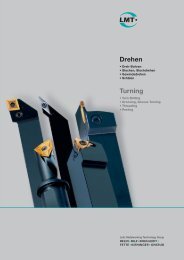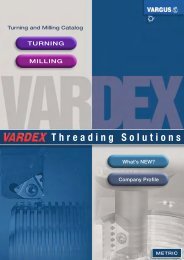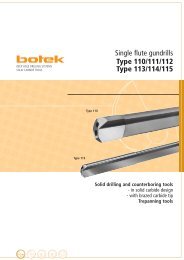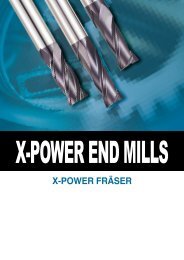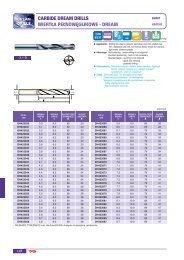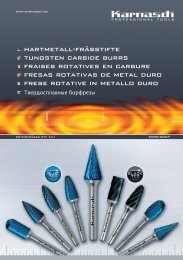Gear Cutting Tools
Hobs - Torion
Hobs - Torion
- No tags were found...
You also want an ePaper? Increase the reach of your titles
YUMPU automatically turns print PDFs into web optimized ePapers that Google loves.
Wear behavior<br />
Flank wear is the chief form of<br />
wear occurring on carbide hobs.<br />
Pitting, which occurs on HSS<br />
hobs, is not normally significant on<br />
carbide hobs. Chipping at the<br />
cutting edge following penetration<br />
of the carbide coating may occasionally<br />
be observed. The chips<br />
may adhere to the uncoated<br />
cutting edge of K types following<br />
penetration of the coating. The<br />
point of first penetration of the<br />
coating must therefore be delayed<br />
as long as possible.<br />
Maintenance<br />
When regrinding solid carbide<br />
hobs, ensure that the thermal<br />
stress on the tooth tip is kept to a<br />
minimum. A defined edge treatment<br />
is also recommended. Depending<br />
upon the hob design (e.g.<br />
positive or negative rake angle,<br />
width of the tooth lands), approximately<br />
10 to 20 regrinds are possible.<br />
The "de-coating" and "re-coating"<br />
processes are required in addition<br />
for hobs manufactured from K<br />
type carbide.<br />
Structural dimensions<br />
The size table indicates the hob dimensions<br />
for which FETTE stocks<br />
carbide blanks. The blanks do not<br />
have drive slots. A drive slot can<br />
therefore be provided on either the<br />
left-hand or the right-hand indicator<br />
hub, as desired by the customer.<br />
FETTE recommends drive slots<br />
with reduced gash depth for carbide<br />
hobs. The gash dimensions<br />
can be found in the table below.<br />
The increase in wear is progressive<br />
from a wear mark width of approx.<br />
0.1 mm upwards, and has a considerable<br />
influence upon the economic<br />
viability of the process. We<br />
therefore recommend that a wear<br />
mark width of 0.15 mm not be exceeded,<br />
and that the cutter be recoated<br />
following each regrind.<br />
Chip adhesion to the worn and<br />
therefore uncoated cutting edges<br />
is much less common with the P<br />
types. Re-coating is not therefore<br />
necessary with these types.<br />
Further information on the maintenance<br />
of solid carbide hobs can<br />
be found on Page 168.<br />
d H5<br />
r 3<br />
A<br />
t 3<br />
H12<br />
r 3<br />
f 2<br />
f 2<br />
b 3<br />
H11<br />
0,2<br />
A<br />
Drive slot dimensions of a carbide hob<br />
Bore diameter b 3 t 3 r 3 f 2<br />
Permissible deviation<br />
Permissible deviation<br />
8 5,4 2,00 0,6 –0,2 0,4 0,1<br />
10 6,4 2,25 0,8 0,5<br />
13 8,4 2,50 1,0<br />
16 2,80 –0,3 0,6 0,2<br />
22 10,4 3,15 1,2<br />
27 12,4 3,50 0,8<br />
32 14,4 4,00 1,6 –0,4<br />
40 16,4 4,50 2,0 –0,5 1,0 0,3<br />
50 18,4 5,00<br />
60 20,5 5,60<br />
70 22,5 6,25 2,5 1,2<br />
80 24,5 7,00<br />
100 8,00 3,0 1,6 0,5<br />
t 3 = 1/2 depth to DIN 138<br />
30



